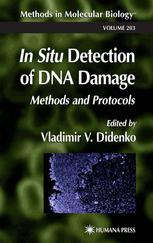

Most ebook files are in PDF format, so you can easily read them using various software such as Foxit Reader or directly on the Google Chrome browser.
Some ebook files are released by publishers in other formats such as .awz, .mobi, .epub, .fb2, etc. You may need to install specific software to read these formats on mobile/PC, such as Calibre.
Please read the tutorial at this link: https://ebookbell.com/faq
We offer FREE conversion to the popular formats you request; however, this may take some time. Therefore, right after payment, please email us, and we will try to provide the service as quickly as possible.
For some exceptional file formats or broken links (if any), please refrain from opening any disputes. Instead, email us first, and we will try to assist within a maximum of 6 hours.
EbookBell Team

4.1
10 reviewsDetection and analysis of DNA damage is critically important in the study of the widest variety of biological phenomena, ranging from apoptosis and aging to heart diseases and anticancer drug development. In In Situ Detection of DNA Damage: Methods and Protocols, Vladimir Didenko and a panel of experts describe all the major in situ techniques for studying DNA damage and apoptosis, and show how approaches originally designed to label apoptotic cells can be used for DNA damage analysis (and vice versa). The readily reproducible techniques presented here include all those designed to detect specific single- and double-stranded DNA breaks in tissue sections while using polymerases, ligases, nucleases, and kinases. In-depth protocols for single-cell electrophoresis (comet assay) are presented, as well as those for the detection of indirect markers of DNA damage and modified bases. Technical reviews discuss specificity, sensitivity, advantages, and limitations of the techniques described, and compare them with alternative approaches.
State-of-the-art and highly practical, In Situ Detection of DNA Damage: Methods and Protocols presents for the first time a complete set of enzymatic methods for determining DNA breaks, and will greatly facilitate the work of all those studying not only the in situ detection of DNA damage but also the labeling of apoptotic cells.